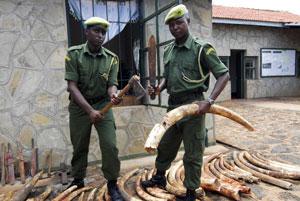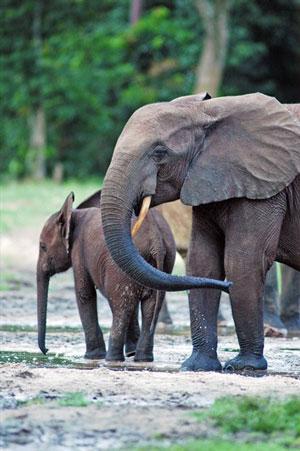If you were to ask Americans to compile a short list of wildlife most associated with Africa, it's a pretty safe bet that elephants would be included.
Unfortunately, it has gotten a lot harder lately to find as many of the iconic animals in central Africa, and a just-released study has confirmed a "devastating decline" in the population of forest elephants.
Despite supposedly safe haven in national parks and game preserves, could they be headed for extinction? The threat now in the 21st century is similar to that of recent centuries -- poachers determined to feed a thriving market for ivory.
Forest Elephants and Savannah Elephants
The home of the forest elephant is stereotypical African jungle, a dense green belt stretching across the center of the continent, not far from the equator. In recent years the sounds of chainsaws and vehicles are heard with increasingly frequency in the jungle, and while loggers, miners, and farmers pose long-term concerns for wildlife, the recent sharp decline of the forest elephants is due primarily to a far deadlier sound'the staccato rattle of gunfire from highly-organized bands of poachers.
Scientists have long divided elephants into two species'Asian and African'but after DNA studies in the past decade, there's increasing acceptance of a new family tree, with African elephants being split into two distinct species: savannah elephants (Loxodonta africana) and forest elephants (L. cyclotis).
As the name implies, forest elephants are found primarily in the heavily vegetated areas of central and western Africa, while their savannah relatives occupy the more open country in eastern and southern parts of the continent. Shorter by several feet and only about half the weight of the savannah elephants, forest elephants have straight rather than curved tusks, different face and ear shapes, and live in smaller groups than savannah elephants.
Unfortunately, their smaller size doesn't diminish the forest elephant's appeal to poachers, who are killing the animals in record numbers in their quest for ivory.
Current Elephant Population Estimates
Estimates of elephant populations are only that, but based on several sources, it's likely that somewhere between 40,000 and 100,000 forest elephants remain in Africa. If so, they account for about 20 percent or less of the total elephant population on the continent. That may sound like quite a few elephants, but consider this: some wildlife groups believe there may have been three to five million African elephants as recently as the 1930s and 1940s.
Until recently, population figures and trends for forest elephants were sketchy at best; the dense vegetation that makes it easy for poachers to escape detection also makes aerial counts of the animals impractical. A recently-released long-term study has provided the first solid information on the status of forest elephants ' and the news is not good.
The research, published in the scientific journal PLoS One, found a "devastating" 62 percent drop in the population for forest elephants in less than a decade. The project spanned a nine-year period (2002'2011) and concentrated on the five countries in Central Africa holding the majority of extant forest elephant range: Cameroon, Gabon, the Central African Republic, the Democratic Republic of the Congo, and the Republic of the Congo.
A Precipitous Drop in Forest Elephant Numbers
According to the study's authors, African forest elephants are being poached at accelerating rates; the population is now less than 10 percent of its potential size and occupies less than 25 percent of its potential range. The reported 62 percent drop in the population occurred in only nine years, a precipitous decline that raises concerns the species could even be on a path toward extinction in the wild.
Just two examples from the study illustrate the extent of the losses: The Democratic Republic of Congo (DRC) is a country historically thought to have the highest numbers of elephants, but 95 percent of that nation's forests are now "likely to be almost empty of elephants... In 2011, less than 2 percent of the Central African forest contained elephants at high density."
Africa's National Parks ' Safe Havens for Elephants?
For many Americans, any mention of wildlife in Africa conjures up mental images of the continent's famous national parks. Surely, we might think, isn't the wildlife situation better in those protected areas?
Unfortunately, that's not always the case, especially in Central Africa, the home range of forest elephants.

Kenya Wildlife Service Rangers with tusks from a savannah elephant. They are holding an axe and a knife used by a poacher to hack off the tusks. Photo © IFAW/N. Grosse-Woodley.
In a report on a major poaching incident in Cameroon's Bouba Ndjida National Park in 2012, the International Fund for Animal Welfare (IFAW) reports that shooting lasted for eight weeks and resulted in the slaughter of at least half of the elephants in the park. The poachers, who were armed with "military grade weapons," traveled on horseback, used camels to haul away the ivory, and reportedly came from Sudan'a trip of over 1,000 kilometers.
Gabon's National Parks Illustrate the Problem
The news from Gabon, which is believed to be home to about half of the surviving forest elephant population, is even more sobering.
Dr. Fiona Maisels of the Wildlife Conservation Society (WCS) has been analyzing the survey data on the elephant population in Gabon's Minkebe National Park. She says, 'Comparing the area already surveyed in 2012/13 with the same area surveyed in 2004 suggests that between 44-77 percent of the elephants have been killed: in other words, that 11,100 elephants have been lost since 2004'.
Authorities in at least some countries are trying to stem the losses, but they are often outnumbered'and outgunned.
Although there's been little trouble for tourists to Africa's popular national parks, it's a different story for the rangers and employees of private game preserves. As poachers become increasingly aggressive, the risks have grown for those working in the parks.
In the summer of 2012, five employees of a wildlife reserve in the Democratic Republic of Congo were killed, reportedly by a gang of elephant poachers. Last September a well-organized pre-dawn attack by illegal hunters in Chad's Zakouma National Park claimed the lives of five game rangers.
The illegal trade in wildlife products "poses an immediate risk to wildlife and to people, including those serving on the frontlines to protect wildlife," says John Scanlon, secretary general of the Convention on International Trade in Endangered Species (CITES).
That statement is echoed by Sean Willmore, president of the non-profit International Ranger Federation (IRF). He says at least 1,000 rangers have been killed in 35 different countries over the last decade. Not all of those deaths were related to poaching, of course, but that risk factor is on the rise. It's a worrisome trend.
Fifty to One Hundred Elephants a Day
According to the Wildlife Conservation Society (WCS), a significant increase in human activity in the Minkebe National Park and its buffer zone was detected in June 2011, and a small camp of 300 artisanal gold miners had expanded to over 5,000 miners, poachers, and arms and drug dealers. Park authorities estimated that 50-100 elephants were being killed daily.
Lee White is head of Gabon's National Parks Agency ' Agence Nationale des parcs Nationaux (ANPN). 'Over the last three years we have deployed 400 additional parks staff, 120 soldiers and 30 gendarmes in our fight to stop illegal killing of elephants for the black market ivory trade," White said.
That's a commendable effort by the small nation, but has it helped?
"Despite our efforts we continue to lose elephants every day," White says. "If we do not turn the situation around quickly the future of the elephant in Africa is doomed. These new results illustrate starkly just how dramatic the situation has become. Our actions over the coming decade will determine whether these iconic species survive.'
A Global Problem Requiring a Global Solution
Richard Ruggiero, Chief of the Branch of the Near East, South Asia and Africa, Division of International Conservation, U.S. Fish & Wildlife Service, notes: 'We are working closely with the Gabonese authorities, who are showing true leadership, but this is a global problem and will require a global solution.'
Bas Huijbregts, Head of the Central Africa strand of World Wildlife Fund's (WWF) Illegal Wildlife Trade Campaign says, "International collaboration of law enforcement agencies is desperately needed to dismantle these international criminal networks. If we don't want to lose Central Africa's remaining elephants, illegal ivory trade needs to be addressed as a serious crime that corrupts governance and seriously erodes national security and economic development prospects.'
The study published in PLoS One notes: "If, conservatively, there were half a million forest elephants in the Congo Basin in 1937 (three elephant generations ago) then about 80 percent have now been lost. The causes of the decline are unlikely to abate in the short term, and indeed may worsen. This strongly suggests consideration of an uplisting of the Central African forest elephant subpopulation status to Critically Endangered, under the IUCN Red List of Threatened Species.
Of course, not everyone supports such listings, or is even concerned about declining elephant numbers. For some in Africa, the animals are simply in the way of progress, are competitors with humans and other wildlife for land and water, or merely a source of revenue for cash-strapped countries. Those viewpoints make it more difficult to achieve consensus for effective steps to protect the animals.
Many Factors Behind the Decline in Elephants
What's behind the dramatic decline in the population of African forest elephants?
Multiple factors are to blame, including loss of habitat to human activity, limited law enforcement resources and an absence of stable governments in parts of Africa. But the major problem is the combination of illegal hunting and rising consumer demand for ivory.

Strong demand for carved ivory is helping drive the increase in poaching. This ivory boat was for sale in Guangzhou, China. Photo by Maxim303 via Creative Commons.
The recently completed study doesn't mince words: "To save the remaining African forest elephants, illegal poaching for ivory and encroachment into core elephant habitat must be stopped. In addition, the international demand for ivory, which fuels illegal trade, must be dramatically reduced."
It's a problem that's receiving considerable attention at a meeting of the Convention on International Trade in Endangered Species of Wild Fauna and Flora (CITES), which is underway in Bangkok, Thailand, from March 3-14, 2013. There has been some encouraging progress.
Will Thailand Take a Big Step for Elephants?
Thailand's Prime Minister Yingluck Shinawatra spoke at the opening of the CITES meeting in Bangkok and announced that her country would take steps to end the ivory trade'the first public statement of this kind by the Thai government. Thailand is currently one of the world's largest ivory markets and much of this ivory is purchased by foreign tourists.
'As a next step we will forward amending the national legislation with the goal of putting an end on ivory trade and to be in line with international norms,' Shinawatra said. 'This will help protect all forms of elephants including Thailand's wild and domestic elephants and those from Africa.'
Representatives of wildlife groups such as the World Wildlife Fund (WWF) welcomed the news. "Ending ivory trade in Thailand'currently the world's largest unregulated ivory market'will go a long way in stemming a global poaching crisis that is leading to the slaughter of tens of thousands of elephants each year and fuelling a global criminal trade in animal parts."
'We're thrilled to hear that Prime Minister Shinawatra took this opportunity to seize the global spotlight and pledge to end ivory trade in her country. But the fight to stop wildlife crime and shut down Thailand's ivory markets is not over. Prime Minister Shinawatra now needs to provide a timeline for this ban and ensure that it takes place as a matter of urgency, because the slaughter of elephants continues,' said Carlos Drews head of WWF's delegation to CITES.
Do Forest Elephants Really Matter?
Other individuals will shrug off concerns about the forest elephant, pointing to the fact that the numbers of savannah elephant are still high enough in some parts of Africa to allow continued legalized hunting. However, the continuing strong demand for ivory has led to a financial windfall for poachers and ivory dealers alike, and those financial factors won't simply disappear if the supply of tusks from forest elephants is depleted.
It's not a situation that bodes well for elephants world-wide, and there's also a lot more at stake for Africa than just the survival of the forest elephants themselves.
"African forest elephants have deep ecological differences from savannah elephants," the study notes." They are highly frugivorous (fruit-eaters) and thus play an important role in one of Earth's primary carbon-sequestering forests. They can move great quantities of large seeds many kilometres from the parent tree and are thus integral for maintaining forest structure and diversity. They also maintain and possibly create forest clearings in mineral-rich soil, on which a wide variety of African forest fauna are dependent."
Ivory Prices and Poaching Are a Deadly Duo for Elephants
Study authors point to increasing demand for and value of ivory in China as a key driver for the steadily growing poaching problem. "It is now clear that elephants in general, and especially the elephants of Central Africa, are under serious threat and that the poaching since 2011 may be at the level at which all elephant populations are in net decline."
The word "poaching" may conjure up mental images of a few rural villagers out to earn some easy cash, but the problem with illegal elephant hunting has taken on a whole new dimension in recent years. The enormous profits associated with the ivory trade have made elephant ivory an attractive funding source for organized crime, insurgent groups and other rogue elements.
'Organized criminal networks are cashing in on the elephant poaching crisis, trafficking ivory in unprecedented volumes and operating with relative impunity and with little fear of prosecution,' said Tom Milliken, the Wildlife Trade Monitoring Network's ivory trade expert.
Major League Poaching
IFAW's Céline Sissler-Bienvenu describes some of what she's learned recently about poaching in western Central Africa:
'Poaching is often conducted by organized professional gangs operating with military-like precision. Their goal is to 'harvest' as much ivory as they can, as quickly as possible. In order to do that, they kill all the elephants in a herd, using modern military weapons, the most common being Kalashnikov AK-47 assault rifles."
"If any elephants escape, some poachers will stay in the vicinity and wait for the survivors to return to mourn their dead," Ms. Sissler-Bienvenu continues. "Then they kill them as well. Such poachers are often foreigners who are not afraid to cross national borders. They not only represent a serious threat to elephants; they may also pose a threat to national security.'
Another report, Elephants in the Dust ' The African Elephant Crisis, has just been released by a consortium of international organizations and provides further information about the scope of the poaching problem and its links to organized crime.
It notes, "Large movements of ivory that comprise the tusks of hundreds of elephants in a single shipment are indicative of the increasingly active grip of highly organized criminal networks on Africa's illicit ivory trade." You can download that document at this link.
Is There Still Hope for Wild Elephant Populations?
In light of all these threats, is there any hope for maintaining a long-term, self-sustaining wild population of elephants in Africa?
The answer likely hinges on whether a concerted international effort can be mounted on several fronts, but some experts say success or failure may hinge on whether it's possible to drastically reduce the world's demand for ivory. A variety of controls on international trading of ivory have been tried in recent deades, with mixed success, and the United States was the first country to ratify CITES in 1975.
Reining in the demand for ivory will be much easier said than done, and a key and perhaps surprising element in the market for those products may prove to be one of the elephant's most formidable foes'the Internet.
Tomorrow on the Traveler we'll take a closer look at the burgeoning market for ivory, its impact on the future of elephants in and outside of African national parks, and efforts to reverse a downward trend for the earth's largest living land mammals





Add comment